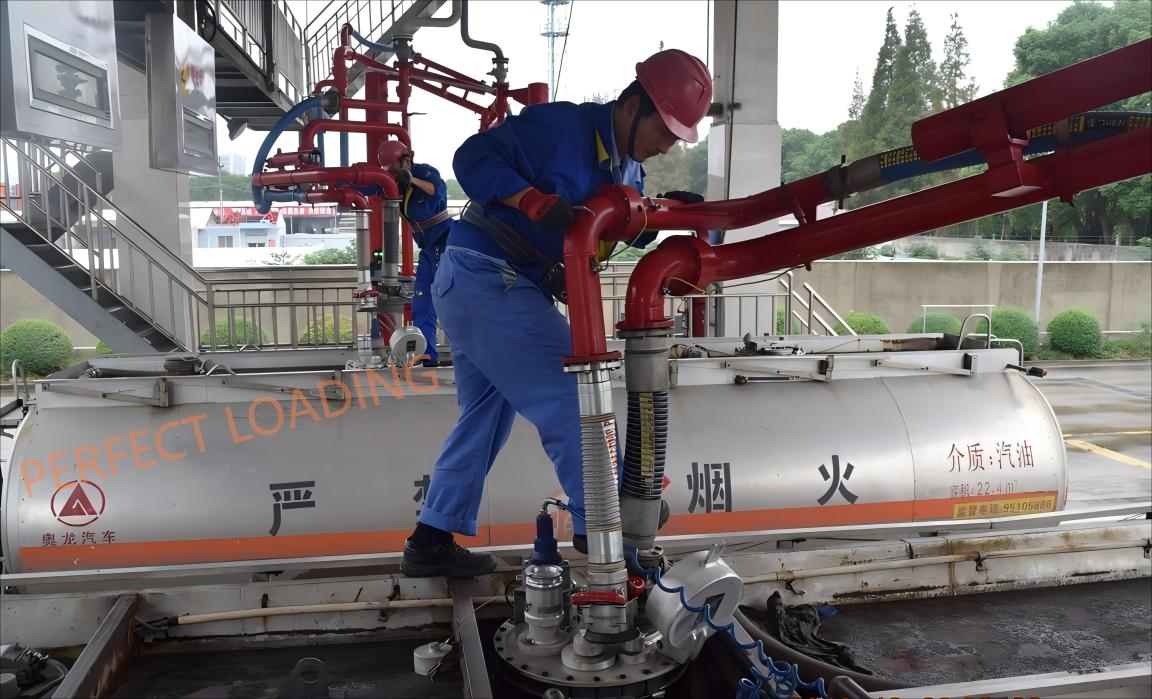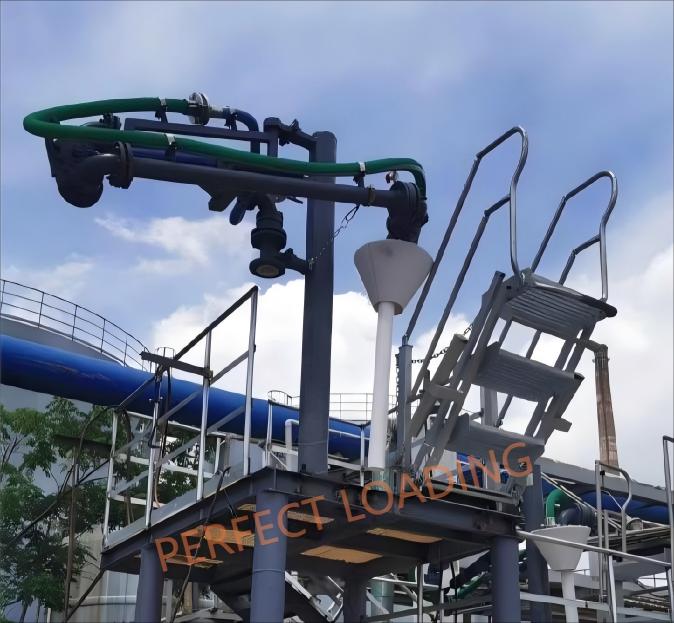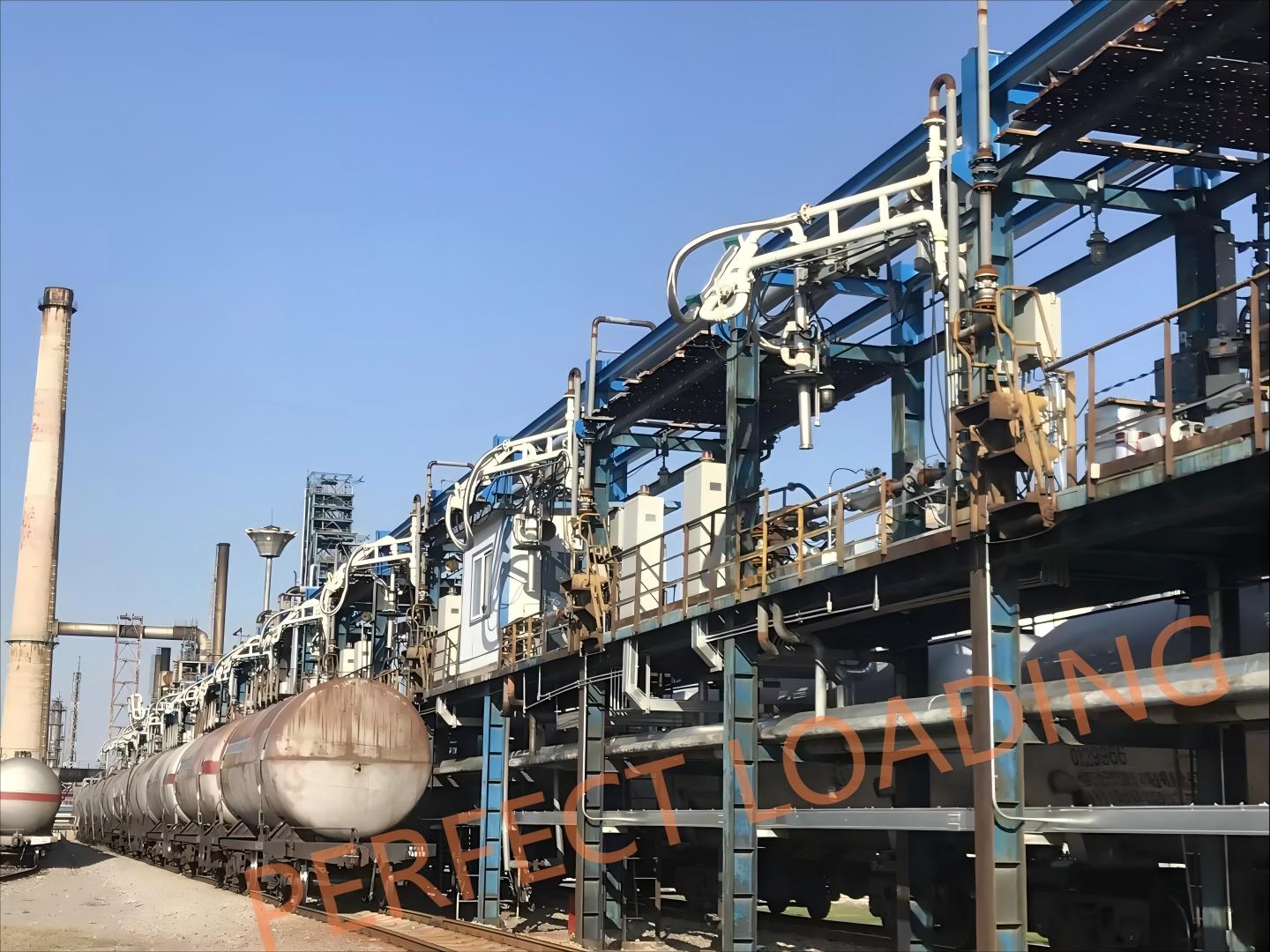2"~6"
PERFECT LOADING
Carbon steel, SS304, SS316L
| Availability: | |
|---|---|
The main arm, typically a rigid pipe with swivel joints, extends over the tanker's top hatch/manhole, delivering liquid
through a drop tube or sealing cone. The piggyback line, a smaller hose or pipe riding along the main arm, connects to a vapor return port on the tanker, recovering displaced vapors and sending them to a recovery unit or storage tank.
The arm’s balance—achieved with spring cylinders, or hydraulic systems—makes it easy for a single operator to position, even over tall tankers. When loading’s done, valves close, and the piggyback line ensures no vapors sneak out during disconnectio
n.
Here is some information on top loading arm for you better understanding the needs in projects.

Top Loading Arm with vapor line and dry coupler

Truck Loading Arm, Folding Stairs, Loading Platform


Pneumatic Top Loading Arm for Rail
One rigid arm handles liquid delivery, while the piggyback line captures vapors, slashing emissions and keeps environment green.
Long reach and swivel joints let you load tankers with varying hatch positions.
Sealing cones or dry-break couplings ensure minimal leakage, keeping your site clean and safe.
Lightweight designs and easy-to-use controls mean one person can handle the job.
The piggyback line traps VOCs, meeting tough environmental standards.
Built to handle harsh conditions—rain, dust, or corrosive chemicals—ensuring years of reliable use.
Liquid arm: 2” to 6” (DN50 to DN150), with 3” and 4” being the most common for fuels or chemicals.
Piggyback line: 1” to 2” for vapor recovery, ensuring efficient gas capture.
Liquid arm: up to 1.6 MPa (16 bar or 232 psi).
Vapor lines handle lower pressures (e.g., 0.1 MPa). Heavy-duty models can hit 2.0 MPa for demanding applications.
-30°C to +100°C (-22°F to +212°F) for standard setups, with specialized options (like PTFE-lined arms) reaching -60°C to +200°C for LPG or cryogenics.
Liquid arm: up to 2,500 liters per minute (660 GPM).
Vapor lines: designed to keep up with displacement rates.
Up to 12 feet (3.6m) horizontally and 10 feet (3m) vertically, accommodating tall tankers or offset hatches.
ASME B16.5 flanges.
These specs make top loading arms versatile for everything from small-scale chemical transfers to high-volume fuel loading.
Carbon Steel: Tough and coated for corrosion resistance, ideal for fuels like gasoline or diesel. It’s like the steel frame of a truck—built to last.
Stainless Steel (SS304/SS316L): Perfect for corrosive chemicals or food-grade liquids, resisting rust and contamination.
PTFE-Lined: For aggressive chemicals like acids, offering top-notch corrosion resistance.
Synthetic Rubber: Flexible and durable for vapor recovery, handling low-pressure gases.
Stainless Steel: Used for high-corrosion or high-pressure vapor applications, like LPG.
Viton (FKM): Resists chemicals and heat, ideal for fuels or acids.
PTFE: Inert for harsh chemicals or sanitary applications.
HNBR/FFKM: High-performance seals for extreme conditions like cryogenics.
Made from carbon steel, stainless steel, or alloys like Hastelloy, ensuring flexibility and durability.
These materials ensure the arms can handle everything from salty marine environments to chemical plants. It’s like outfitting your gear for a rugged adventure—tough, reliable, and ready for anything.
Standard for liquid and vapor lines, available in 2” to 6” sizes with pressure ratings from Class 150 to 2500. These ensure a tight, leak-free connection to tanker hatches.
4” API RP 1004 couplers for quick connect/disconnect, perfect for fuel terminals. They snap on and off with minimal leakage.
Often paired with the liquid arm for a tight seal on tanker hatches, enhancing spill prevention.
Load gasoline, diesel, or jet fuel into tankers while capturing VOCs to meet emission standards. The piggyback line keeps the air clean.
Handle acids, solvents, or caustic liquids with PTFE-lined arms and vapor recovery for safe, green transfers.
Transfer crude oil or refined products with precision, using vapor lines to control emissions during high-volume loading.
Manage liquefied petroleum gas or cryogenic fluids, where vapor recovery prevents dangerous pressure buildup.
Transfer edible oils or syrups with stainless steel arms and FDA-approved seals, ensuring hygiene while capturing any vapors.
These loading arms come with a range of accessories to boost their game:
Enhance liquid arm sealing on tanker hatches, reducing spills.
Prevent spills during pull-aways, protecting equipment and the environment.
Monitor tank levels to avoid overfilling, adding a safety layer.
Eliminate static risks, critical for flammable liquids.
Steam-jacketed or trace-heated arms maintain fluid temperature in cold climates.
Extend the arm over the tanker’s hatch, aligning the liquid arm with the fill port and the piggyback line with the vapor return port. Use a sealing cone or API coupler for a secure connection.
Adjust spring cylinders for easy positioning, even over tall tankers.
Open the valves to start liquid flow, with the piggyback line capturing displaced vapors. A mass flow meter (if included) tracks volume.
Check the control panel or sensors for flow, pressure, and tank levels to prevent overfills.
Close valves, disconnect the coupler or sealing cone, and retract the arm. Dry-break couplings and the piggyback line ensure minimal leakage and vapor escape.
Check swivel joints, seals, and hoses for wear or leaks. A worn seal is like a leaky pipe—fix it fast.
Remove residue to prevent corrosion, especially for chemical or food-grade applications.
Swap out Viton or PTFE seals if cracked, using spare kits for quick repairs.
Keep joints moving smoothly with manufacturer-approved lubricants.
Ensure breakaway couplers, overfill sensors, and vacuum breakers work correctly for safety.
High-quality arms and accessories (like API couplers) can be pricey, but they pay off long-term.
Swivel joints and seals need regular checks to stay leak-free.
Operators need training for top loading safety, including harness use and vapor recovery.
Requires precise alignment with tanker hatches, like solving a puzzle.
One month after order and drawings confirming
The main arm, typically a rigid pipe with swivel joints, extends over the tanker's top hatch/manhole, delivering liquid
through a drop tube or sealing cone. The piggyback line, a smaller hose or pipe riding along the main arm, connects to a vapor return port on the tanker, recovering displaced vapors and sending them to a recovery unit or storage tank.
The arm’s balance—achieved with spring cylinders, or hydraulic systems—makes it easy for a single operator to position, even over tall tankers. When loading’s done, valves close, and the piggyback line ensures no vapors sneak out during disconnectio
n.
Here is some information on top loading arm for you better understanding the needs in projects.

Top Loading Arm with vapor line and dry coupler

Truck Loading Arm, Folding Stairs, Loading Platform


Pneumatic Top Loading Arm for Rail
One rigid arm handles liquid delivery, while the piggyback line captures vapors, slashing emissions and keeps environment green.
Long reach and swivel joints let you load tankers with varying hatch positions.
Sealing cones or dry-break couplings ensure minimal leakage, keeping your site clean and safe.
Lightweight designs and easy-to-use controls mean one person can handle the job.
The piggyback line traps VOCs, meeting tough environmental standards.
Built to handle harsh conditions—rain, dust, or corrosive chemicals—ensuring years of reliable use.
Liquid arm: 2” to 6” (DN50 to DN150), with 3” and 4” being the most common for fuels or chemicals.
Piggyback line: 1” to 2” for vapor recovery, ensuring efficient gas capture.
Liquid arm: up to 1.6 MPa (16 bar or 232 psi).
Vapor lines handle lower pressures (e.g., 0.1 MPa). Heavy-duty models can hit 2.0 MPa for demanding applications.
-30°C to +100°C (-22°F to +212°F) for standard setups, with specialized options (like PTFE-lined arms) reaching -60°C to +200°C for LPG or cryogenics.
Liquid arm: up to 2,500 liters per minute (660 GPM).
Vapor lines: designed to keep up with displacement rates.
Up to 12 feet (3.6m) horizontally and 10 feet (3m) vertically, accommodating tall tankers or offset hatches.
ASME B16.5 flanges.
These specs make top loading arms versatile for everything from small-scale chemical transfers to high-volume fuel loading.
Carbon Steel: Tough and coated for corrosion resistance, ideal for fuels like gasoline or diesel. It’s like the steel frame of a truck—built to last.
Stainless Steel (SS304/SS316L): Perfect for corrosive chemicals or food-grade liquids, resisting rust and contamination.
PTFE-Lined: For aggressive chemicals like acids, offering top-notch corrosion resistance.
Synthetic Rubber: Flexible and durable for vapor recovery, handling low-pressure gases.
Stainless Steel: Used for high-corrosion or high-pressure vapor applications, like LPG.
Viton (FKM): Resists chemicals and heat, ideal for fuels or acids.
PTFE: Inert for harsh chemicals or sanitary applications.
HNBR/FFKM: High-performance seals for extreme conditions like cryogenics.
Made from carbon steel, stainless steel, or alloys like Hastelloy, ensuring flexibility and durability.
These materials ensure the arms can handle everything from salty marine environments to chemical plants. It’s like outfitting your gear for a rugged adventure—tough, reliable, and ready for anything.
Standard for liquid and vapor lines, available in 2” to 6” sizes with pressure ratings from Class 150 to 2500. These ensure a tight, leak-free connection to tanker hatches.
4” API RP 1004 couplers for quick connect/disconnect, perfect for fuel terminals. They snap on and off with minimal leakage.
Often paired with the liquid arm for a tight seal on tanker hatches, enhancing spill prevention.
Load gasoline, diesel, or jet fuel into tankers while capturing VOCs to meet emission standards. The piggyback line keeps the air clean.
Handle acids, solvents, or caustic liquids with PTFE-lined arms and vapor recovery for safe, green transfers.
Transfer crude oil or refined products with precision, using vapor lines to control emissions during high-volume loading.
Manage liquefied petroleum gas or cryogenic fluids, where vapor recovery prevents dangerous pressure buildup.
Transfer edible oils or syrups with stainless steel arms and FDA-approved seals, ensuring hygiene while capturing any vapors.
These loading arms come with a range of accessories to boost their game:
Enhance liquid arm sealing on tanker hatches, reducing spills.
Prevent spills during pull-aways, protecting equipment and the environment.
Monitor tank levels to avoid overfilling, adding a safety layer.
Eliminate static risks, critical for flammable liquids.
Steam-jacketed or trace-heated arms maintain fluid temperature in cold climates.
Extend the arm over the tanker’s hatch, aligning the liquid arm with the fill port and the piggyback line with the vapor return port. Use a sealing cone or API coupler for a secure connection.
Adjust spring cylinders for easy positioning, even over tall tankers.
Open the valves to start liquid flow, with the piggyback line capturing displaced vapors. A mass flow meter (if included) tracks volume.
Check the control panel or sensors for flow, pressure, and tank levels to prevent overfills.
Close valves, disconnect the coupler or sealing cone, and retract the arm. Dry-break couplings and the piggyback line ensure minimal leakage and vapor escape.
Check swivel joints, seals, and hoses for wear or leaks. A worn seal is like a leaky pipe—fix it fast.
Remove residue to prevent corrosion, especially for chemical or food-grade applications.
Swap out Viton or PTFE seals if cracked, using spare kits for quick repairs.
Keep joints moving smoothly with manufacturer-approved lubricants.
Ensure breakaway couplers, overfill sensors, and vacuum breakers work correctly for safety.
High-quality arms and accessories (like API couplers) can be pricey, but they pay off long-term.
Swivel joints and seals need regular checks to stay leak-free.
Operators need training for top loading safety, including harness use and vapor recovery.
Requires precise alignment with tanker hatches, like solving a puzzle.
One month after order and drawings confirming